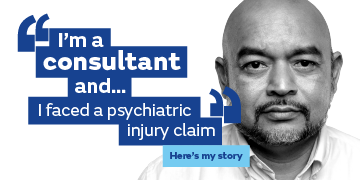Dealing with aggressive patients
Post date: 17/11/2020 | Time to read article: 3 minsThe information within this article was correct at the time of publishing. Last updated 08/05/2024
Dr Clare Devlin, Medicolegal Consultant at Medical Protection, offers advice on handling an aggressive patient
Over a third of doctors have experienced verbal or physical abuse from patients or patients’ relatives during COVID-19, according to Medical Protection’s recent survey of 1,250 UK doctors. A further 7% of doctors reported receiving verbal or physical abuse outside a medical setting. This follows reports that GPs are facing abuse and complaints from patients who believe they aren’t offering enough face-to-face appointments, despite the number of face-to-face appointments increasing in recent months.
Preparations for dealing with aggressive patients
Some patients have a history of aggressive behaviour, so you may anticipate recurrence, particularly in times of widespread stress and uncertainty, such as the current pandemic. For other patients, aggressive behaviour is uncharacteristic, but remember that aggression may present as a feature of an underlying physical or mental condition.
It is helpful to have a practice policy to deal with aggressive behaviour and ensure that staff have received training in conflict avoidance. This may enable signs of aggression to be recognised at an early stage, such as body language signalling increasing frustration or anger, thus avoiding escalation.
Patients can be made aware of your practice policy by placing a notice in the waiting room or on the practice website.
When faced with an aggressive patient
You may be able to defuse the situation by remaining calm and clearly demonstrating a willingness to help the patient. Try to avoid raising your voice or adopting confrontational body language, such as crossed arms or entering the patient’s space. Allowing the patient to talk and listening to them often helps, as does acknowledging their feelings and perspective – understanding their point of view does not mean that you agree with it. Asking open questions may help calm the situation, or you might feel it is better to allow the patient to speak uninterrupted.
You can identify if the patient has any legitimate concerns and, if appropriate, apologise and offer to discuss and address any complaints, although a productive discussion is likely to take place at a later point when emotions are less heightened.
You need to be mindful of your own safety, considering whether you are in a position to leave the room if necessary. In a situation of violence or anticipated violence, call the police, rather than attempting to physically escort the patient from the premises.
After the incident
It can be distressing to deal with an aggressive patient, so debriefing with supportive colleagues can be valuable and generate useful learning points about ways to manage a similar situation in the future.
You should consider whether to document the patient’s aggressive behaviour on a case by case basis. If you believe it is likely to be relevant to their health, it should be documented in their medical record. The GMC advises information recorded in the patient’s notes must be factual and objective, and should not include anything that could unfairly prejudice their future treatment. Personal opinions should not be included, and instead of stating a patient was aggressive, it would be preferable to give a factual description of the words they used, their tone of voice, gestures and posture.
It is important to remember that information held by the practice about a patient, whether in the medical records or elsewhere, would need to be disclosed at their request under GDPR.
Warning a patient about their behaviour
You may wish to consider giving the patient a warning about their behaviour. However, warnings may be the trigger for a complaint, so it is important to take care with the wording of any warning letter. You should set out in neutral terms the behaviour you do not wish to be repeated and the consequences; for example, that repeated incidents of a similar nature could result in consideration of the patient’s future with the practice. It can also be effective to start with an apology for any issues that had upset the patient, for example delays or communication problems.
You can explain you understand the patient may have been distressed or anxious, before then outlining that this is still not an excuse for unacceptable behaviour. It is helpful not to make direct accusations, but rather refer to any aggression or intimidation in terms of it being the perception of the staff concerned. You could add that you realise the patient might not have been aware of the effect of their behaviour and give them an opportunity to provide comments. This can often lead to an apology from the patient, which enables swift resolution.
Removal from the practice list
The GMC has specific guidance setting out issues to consider and steps to take before ending the relationship with a patient, and how to carry out removal. You will also need to act in line with your contractual obligations.
In situations where a patient has committed an act of violence or made someone at the practice fearful for their safety, they can be removed from the list via a different route with immediate effect. The stages in the process to be followed are explained clearly on the BMA website, but the first step is to call 999 or your local police station as soon as possible, to provide details of the incident (relaying the minimum information necessary), ask for police assistance if required and request the incident number.


